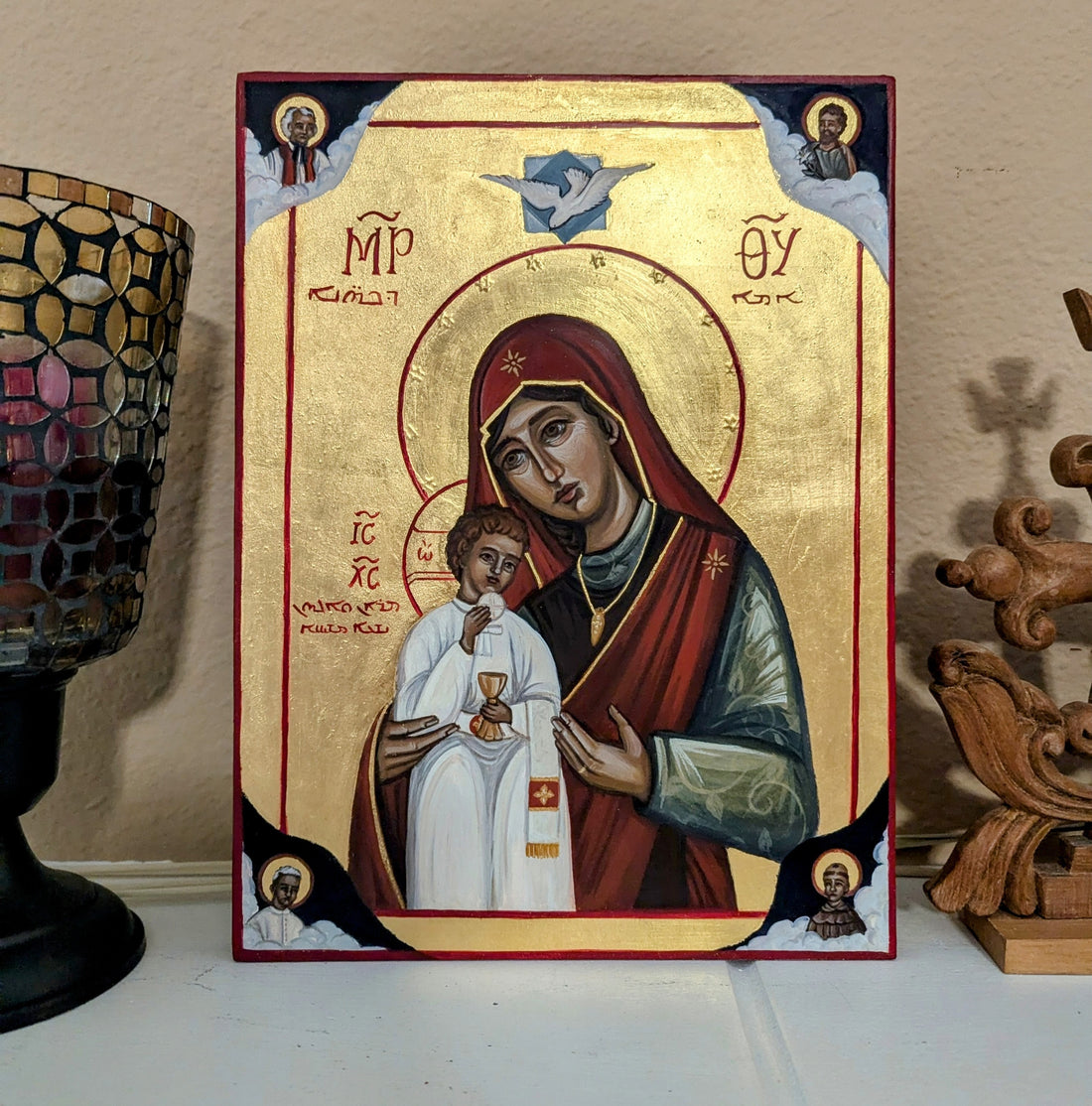
Designing an Icon: Mother of Priests (and Seminarians)
Share
Thanks to Fr.Joby Joseph for collaborating with me on this icon as well as co-writing this blog post!
Designing an icon for the first time with Fr.Joby was a deeply spiritual and meaningful endeavor. We took time to review tradition, scripture, and aesthetics to develop this new liturgical object. The "Mother of Priests" is a captivating piece of sacred art that reflects profound spiritual truths, particularly around vocations. Through its rich symbolism, this icon narrates the journey of priestly formation, the role of the Virgin Mary, and the outpouring of heavenly grace.
Fr.Joby's Inspiration
“I am a big proponent of sacred art: I find that it raises my mind and heart to contemplation and love for the Divine. In prayer, particularly as the relatively new assistant vocation director, Christ the High Priest and priestly formation have been in the forefront of my thoughts. It was in this space of prayer that this image emerged.”
The Symbolism of Jesus the Seminarian
At the center of the icon is the child Jesus, adorned with the Syro-Malabar vestments (namely a kothina, sunara, and urara). The kothina, a white inner garment corresponding to what the Latin Church refers to as an alb, symbolizes the priest “putting on Christ” by virtue of his baptism and choosing to live a life of holiness and righteousness. The sunara, the belt corresponding to the Latin cincture, symbolizes a commitment to chastity and integrity in order to be of service to God. The urara, the stole, symbolizes the authority of the priest. What is notable is that Jesus, the High Priest, is vested as if He was a karoya, the first minor order a man receives along the journey to priesthood. The absence of the kappa, the outer garment worn by priests, is intentional. This decision was both to demonstrate how the Supreme Lord God, Jesus Christ the Eternal High Priest, humbled Himself to our lowly human state and, Himself, grew in knowledge and wisdom. Much like the priests who configure themselves into His image in time, He revealed His true identity in time. This artistic rendering also found an antecedent in a mosaic found in the Patriarchal Seminary in Beit Jala, Palestine.

The decision for Jesus to be vested in white surely emphasizes His divine nature. This also complements the vesture of the Virgin Mary in light of the altar cloth of the West Syriac Tradition. According to the West Syriac liturgical practice, the Holy Eucharist (Jesus Himself) is enthroned on a cloth of three concentric rectangles of white, green, and red. These colors represent the throne (white), creation (green), and the universe (red). On the altar, as well as in this icon, we see that Jesus is the focal point of creation and the universe, the source of all holiness. Similarly, the Virgin Mary, the pride and greatest of creation, is given a base garment of green and draped in red, recalling how the Divine has looked with favor on her and made her the Queen of the Universe. Nonetheless, her splendor is always contingent and oriented toward Jesus.

The Symbolism of Mother Mary
Our Lady is depicted with a green blouse and draped in a red saree. The green signifies creation, as mentioned above, as well as health, life, fertility and hope. The decorative vines on her blouse further emphasize this symbolism and her role as the Mother of Christ, Who is God, the True Vine. The red saree doubles as her manthrakodi, the saree gifted to the bride by her bridegroom. This reminds us that our Lady is the model of the Church, the Bride of Christ, and how He showers and bestows divine grace upon her. In Byzantine iconography, red is often used to symbolize divinity. The red saree reminds us that Mary is not a divine person, but has been undoubtedly favored and overshadowed by the Divine.
The attentive eye would notice that Mary is wearing a brown garment beneath her saree and above her blouse. Many faithful wear the brown scapular, which our Lady entrusted to the Order of Carmel, as for protection and a constant reminder of Mary’s maternal presence. This inclusion hints to this tradition in the spiritual treasury of the Church as well as Fr. Joby’s personal devotion to Our Lady of Mount Carmel and the Carmelite saints.
Mary is also notably adorned with a ring and thaali, highlighting both her earthly and eternal roles. Much like how Jesus is envisioned according to the Syro-Malabar Tradition, so is Mary. Mary was a married woman, and her ring and thaali recall her chaste marriage to St. Joseph. However, these symbols which adorn a bride also serve as a reminder of her eternal status as the Bride of the Holy Spirit and the model of the Church, the Bride of Christ.
While it is not customary in Byzantine iconography to have the hair of the Virgin Mary seen, this image has her hair visible as a braid veiled by her saree. This decision was to have another earthly touchstone for Jesus— His earthly and human generation comes from Mary: her eyes, her skin, her hair. It was a means to visible demonstrate the biological closeness of Mother Mary and Jesus, the Son of God.
The Composition
The closeness of Mary and Jesus in the icon is designed to convey a deep sense of mutual tenderness, affection, and support. However, Mother and Child are attentive to the viewer and invite them into the mystery. Jesus offers Himself, eucharistically and otherwise, and Mary points the way to her beloved Son. The icon also captures the Holy Spirit’s role in the sanctification of creation. Just as the Holy Spirit descended and overshadowed Mary at the Incarnation of Christ, during the epiclesis of the Holy Qurbana, the Holy Spirit descends upon the bread and wine and transforms it into the Body and Blood of Jesus Christ. Here, the Holy Spirit's presence (depicted as a dove) is descending upon Mary and Jesus, reinforcing the connection between the economy of salvation and the sacramental life of the Church.
The Four Witnesses
The icon is framed by four saints, each representing a witness to the priestly vocation and Fr. Joby’s personal journey.
- St. Joseph: As Mary’s chaste spouse, St. Joseph represents the sanctity of the marital vocation and paternal care, grounding the icon in the reality of human relationships and responsibilities. St. Joseph is the God-chosen defender of Jesus and Mary, much to the same calling a priest is called. He spent his life in their constant company and devoted his entire life to them. Though patron of many, he is notably the patron of all Christian families, the Church, and Fr. Joby.
- St. John Vianney: St. John Vianney’s sanctity has fairly recently named him “the patron of priests.” He embodies the ideal of pastoral dedication and the loving shepherding of the faithful.
- St. Junipero Serra: St. Junipero Serra left the comforts and prestige of life in Spain to spend the rest of his days as a missionary in California. St. Junipero Serra symbolizes the call to spread the Gospel to all people and to tirelessly serve the Church with one’s whole being. Fr. Joby is proud to have this saint buried in his home state of California.
- Blessed Kunjachan: A son of the Syro-Malabar Church who lived a profoundly holy life through his simple ministerial life, care for the poor, and concern for the marginalized. Blessed Kunjachan was famously known for baptizing thousands of dalits, the untouchables who were ignored and excluded by the general Syro-Malabar community of his time. He was a priest of the Diocese of Palai, the diocese Fr. Joby’s ancestral roots hail from.
Conclusion
This icon of our "Mother of Priests" is a deeply theological and spiritually rich work of art. It stands as a testament to the divine and human dimensions of the priestly vocation, offering a visual meditation on the intersection of divine grace, motherly care, and the sacred ministry. The icon not only honors the role of Mary and Jesus but also celebrates the ongoing support and inspiration provided by the saints who guide and accompany those in formation.
